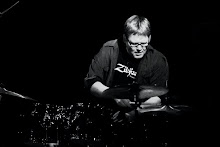Hey everybody! We're doing something very special this week.. I have combined forces with fellow bloggers Cruise Ship Drummer and Four on the Floor to bring 3 different views of a topic. Jon McCaslin from "4" suggested we discuss concepts involving hi-hat with our foot, so here's my contribution!
First, at little background to my exercises. I have thought about the hi-hat a lot in recent years. It is the newest permanent member of the drum set family, and arguably it's most complex instrument. It can be a short sound, long sound, can be played with either the hands or the foot, or both together. This last idea brings me to these exercises. At some point, I discovered if I viewed what the hands (most of the time the RH ) and left foot were doing as separate entities, I came up with open/closed combinations I wouldn't have though of otherwise. So here are the exercises….
The first one is the most obvious. If we play a standard Rock beat, we get Disco if we play our LF in quarter notes, and if we play our left foot on upbeat 8ths, it gives us a sort of Tony Thompson Power Station thing…..
Note on most of these I begin by playing the RH part on the rim of a tom so we can hear the two parts separately.
The second one is a standard rock beat, but the left foot is playing dotted quarters so it creates a nice over the bar line thing with the open and closed hi-hat sound….
The next three examples use the Jazz Ride Rhythm in the RH, and quarter notes, up beat 8ths, or quarter note triplets in the LF. Note I usually also present the pattern with the LF as splashed notes……
Now, let's try some ideas with the cascara rhythm in the RH. It's presented with LF on 1&3, 2&4, and all 4 beats respectively….
Finally, the last two examples employ either quarter note or displaced quarter note triplets in the LF while playing a standard Rock beat with the hands. The extra wrinkle in these is the "grind" the str. 8ths creates against the triplets….
Obviously, these last two aren't going to win you any friends if you play them on a Country gig! ( Nor would I ever suggest you utilize them this way.) All I'm attempting to demonstrate is some of the cool textures you can create using any of your favourite RH and LF patterns together on the hi-hat. Experiment with it, and see what you come up with that you like. This is a way we can all come up with our personal vocabulary, and have fun and challenge ourselves while we do it!
Epilogue:
I wrote this before I saw Jon's excellent post this morning and wanted to say I completely concur with all of Jon's conceptual Hi-Hat information. Be willing to play hi-hat on 2 & 4, because that will work great a lot of the time, but also be willing to be adventurous and let go of it, if need be. Also, if you are an ambitious hi-hat person like myself, don't "lean" on your left foot as a way to make you're playing self-consciously hip! Quick story, I was playing at a band festival in Brandon Manitoba over a series of days, and luckily enough, the great Matt Wilson was there with his group as well. At the end of the festival, there was a big hang with the guest artists, adjudicators, and students. Some students were the house band, they sounded great. Matt got up and played, he sounded great. I got up and played, I sounded, well, like someone who had just noticed there was no hi-hat, and was messed up by this! I hadn't noticed this before, because the other drummers sounded so comfortable. The lesson here? Keep redefining your approaches to organizing/orchestrating your instrument, and keep your humility at close range! :)

This comment has been removed by the author.
ReplyDeleteSounds Great! Cool ideas and wonderful break down of a bunch of helpful exercises. I was having fun with a Ska beat the other day where the L.F. only closes on 2 and 4; staying open on all other beats. Swung or straight with various R.H. parts and a one drop (bass and side stick on 2 & 4)creates interesting Hi-hat textures with a simple lift on all but 2 and 4.
ReplyDeleteOoh! Sounds great. Film it and show us Sam! :)
Delete